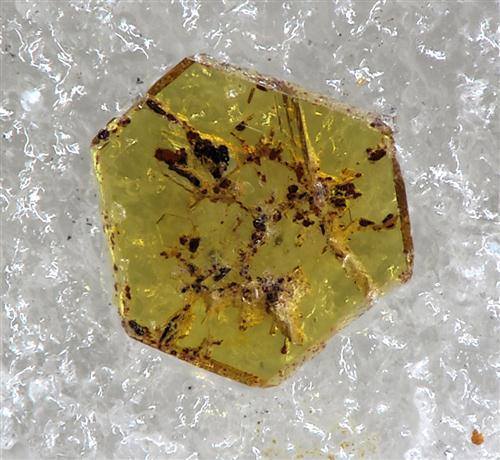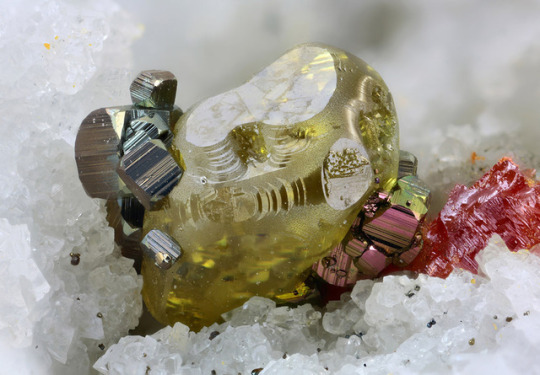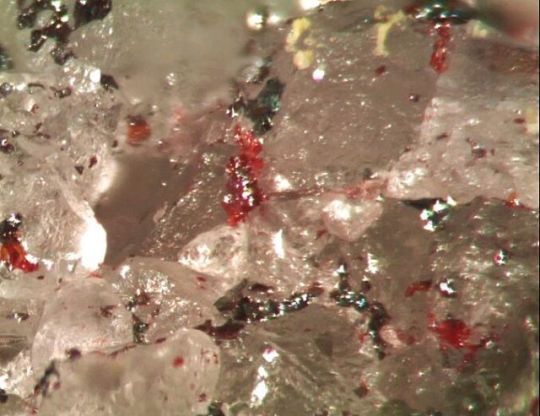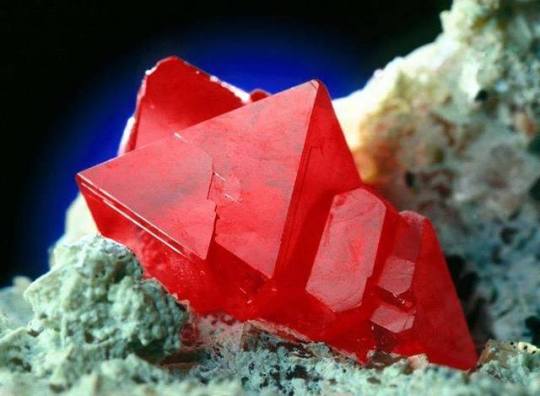#micromounts
Video
Pyromorphit by Harald Biecker
Via Flickr:
Pyromorphit, Grünbleiberg, Niedergelpe, Berg. Land; Bildbreite FOV 4 mm OMD EM5 II; Stackmaster Schneider Componon S 50 Helicon Pro
7 notes
·
View notes
Photo

Agardite and conichalcite
Micromounting is the collection of photogenic minerals that can only be seen under the microscope. We did an article promoting the advantages of such a collection in terms of storage, cost and transport at http://tinyurl.com/kzlp9ky. They often display perfection of colour and crystal habit unthinkable in macro scale crystals at anything less than thousands of dollars. Great specimens can be found for yourself in abandoned mines.
Unlike the specimen in the post linked above, which evokes visions of fire, the wonder in this photo evokes a marine scene, with sea urchins that formed in the oxidised zone of a rare earth bearing oxidised zone of a copper ore deposit. Yellow green crystals of the rare earth hydrated arsenate mineral agardite have formed on top of tufts of bright blue needles of the calcium copper arsenate mineral conichalcite. The specimen comes from the Imperial Mine in Nevada and the field of view is 4.5mm.
Loz
Image credit: Yaiba Sakaguchi http://www.mindat.org/min-46.html http://www.galleries.com/minerals/phosphat/agardite/agardite.htm http://www.dakotamatrix.com/mineralpedia/4894/agardite-la http://www.mindat.org/min-1119.html http://www.galleries.com/Conichalcite http://www.dakotamatrix.com/mineralpedia/5864/conichalcite
314 notes
·
View notes
Photo

Been a while since I posted minerals. Ammoniozippeite is a newly discovered uranium mineral (2019). Analysed sample from Hungary. . #geology #geologists #geologyporn #geologist #nature #micromount #geomorphology #hungary #collection #mine #uranium #zippeite #green #ammoniozippeite #new #minerals #mineral #crystals #mineralporn #indie #grunge #chriswashere #chrisiaitis https://www.instagram.com/p/By-nS7cHSJu/?igshid=b03wn8w90lt5
#geology#geologists#geologyporn#geologist#nature#micromount#geomorphology#hungary#collection#mine#uranium#zippeite#green#ammoniozippeite#new#minerals#mineral#crystals#mineralporn#indie#grunge#chriswashere#chrisiaitis
5 notes
·
View notes
Photo

Jarosite. This photo is taken through a microscope, so this specimen is very tiny. ;-)
From my personal collection. My english is sadly too poor to give a full geological description, so if you want to know more, you will have to google. ^^’’
1 note
·
View note
Photo

From Mindat.Org Photo Of The Day; March 22, 2018:
Sphalerite: ZnS; Pyrite: FeS2; Realgar: As4S4
Locality: Lengenbach Quarry, Fäld (Imfeld; Im Feld; Feld), Binn Valley, Wallis (Valais), Switzerland
“3.98 mm group with yellow Sphalerite crystal, red Realgar and Pyrite crystals. Collection & Photo Matteo Chinellato. First place in the micromount division of the Mineral Photography competition at the 2018 Tucson Gem & Mineral Show"
7 notes
·
View notes
Photo

Ivuna meteorite. Rare type fall of all CI-type carbonaceous chondrites. Shown in photo is the main mass held by the London Natural History Museum. Micromount specimens available at Galactic Stone & Ironworks.
0 notes
Photo

#ad Galkhaite: "Twofer" Micromount(s): Getchell Mine, Manhattan, NV, ex-Henderson https://t.co/7QVHQdaidy https://t.co/7QVHQdaidy (url directs to actual product on ebay)
0 notes
Photo

Hall of Fame to induct Barwood for his work Lacey Alexander Staff Writer In addition to having a mineral he discovered be named in his honor, Henry Barwood, a late Troy geology and earth and space professor, will also be inducted into the Micromounters’ Hall of Fame on Oct.
0 notes
Video
Wulfenite by Harald Biecker
Via Flickr:
tabular wulfenite crystals with white Calcite Ahmad Abad Mine; FOV 4.5 mm; OMD EM5 MII on Stackmaster; Componon S 50 mm; stacked with Helicon Focus
#micromounts#minerals#crystals#Mineralien#Kristalle#Wulfenit#Calcit#Macro#DOF Stacking#wulfenite#calcite#Helicon Focus#Olympus#OMD EM5 MarkII#Focus-Stacking#flickr
3 notes
·
View notes
Text
Micromounts and the Future of Collecting
According to some mineral collectors, among whom I include myself, micromounting has more to offer the mineral hobbyist and collector than any other niche of mineralogy. Conversely, I've heard seasoned and serious collectors say that the hobby is dying out. "I've checked out their symposia," one notable collector once told me," and there wasn't anyone there under 60." Perhaps he was correct, but things could change.
The relative dearth of young people interested in mineralogy extends beyond micromounting. Mineral enthusiasts of all stripes lament how their ranks are aging. Possible reasons could be competition wrought by technology, former localities succumbing to sprawl, and increasingly restricted access to quarries, mines, and construction sites. Ever skyrocketing prices for hand and cabinet specimens present another obstacle. Micromounts have the potential to become a big part of the answer.
A partial inspiration for this post was a presentation at the recent Rochester Mineralogical Symposium by Quintin Wight, probably the world's premier micromounting authority, entitled "The Pleasures of Micromounting," Every year, Quintin travels the globe to attend major micromounting events. He then contributes a major article chronicling his travels entitled "Through the Scope: The Year in Micromounting" to Rocks and Minerals. Quintin also authored the the beautifully illustrated 273 page hardcover publication The Complete Book of Micromounting, which Mineralogical Record published in 1993.
While Quintin covered much of what this post seeks to communicate, it's important to recognize that he, as well as most of the important players in the world of micromounts define their hobby in terms of "micromounting" and refer to themselves as "micromounters." Putting together a mount can be time consuming. Quintin has a procedure that takes three days. Furthermore, for those with poor finger dexterity, mounting a micromineral can be unpleasantly challenging as well as lead to the destruction of beautiful and sometimes valuable material. Somewhat overlooked in Quintin's presentation was that one need not be a a micromounter to collect and love micromounts.
The enjoyment of micromounts requires no more than a binocular microscope and effective lighting. For one interested in photographing micromounts, a trinocular scope is preferable. The pleasures to be enjoyed thereafter are as follows:
The variety of species to be collected, whether self-collected in the field, purchased, or traded is greater by multiples. For that matter, many---arguably a majority--- of the most beautiful of the approximately 4700 known mineral species (not to mention varieties of any given species) require magnification to be appreciated. Many require magnification even to be visible.
The quality of crystals as determined by beauty, level of development, and freedom from damage is always going to be the smaller the better.
More features of a mineral are visible under the scope. Included among these features are habits and associated minerals.
Species suitable for micromounting are far more likely to be self-collectible. To collect larger specimens, one has to be able to see them. To collected microscopic minerals, one needs only to know where and how to look for them.
Micromounts take up less space than cabinet specimens. Half a cubic foot can hold 500 mounts.
Micromounts are far less expensive than cabinet specimens and are affordable to anyone. Quality material for micromounting, including many rare species, can be obtained free from give-away tables at micromount symposia.
We note these points as an expression of the potential role of micromounts not just for the future of mineral collecting, but for the present as well.
0 notes
Video
Erythrine by Harald Biecker
Via Flickr:
Erythrine crystals from Bou Azer in two generations; FOV 8 mm, stacked with helicon Focus Erythrinkristalle in zwei Generationen, Aghbar, Bou Azzer Marokko, BB 8 mm; gestackt mit Helicon, Nikon D7000 an Nikon Balken auf Stackmasterschlitten mit Componon S 50.
#Mineralien#minerals#Micromounts#Macro#Marokko#erythrine#crystals#Kristalle#dofstacking#focusstack#Helicon#Nikon#D7000#Bou Azzer#Erythrin#Kobaltblüte#Helicon Focus#flickr
2 notes
·
View notes
Video
Wulfenite by Harald Biecker
Via Flickr:
tabular wulfenite crystals with white Calcite Ahmad Abad Mine; FOV 4.5 mm; OMD EM5 MII on Stackmaster; Componon S 50 mm; stacked with Helicon Focus
#micromounts#minerals#crystals#Mineralien#Kristalle#Wulfenit#Calcit#Macro#DOF Stacking#wulfenite#calcite#Helicon Focus#Olympus#OMD EM5 MarkII#Focus-Stacking#flickr
0 notes
Photo

Red Arsiccioite & black Protochabourneite are two recent mineral species named. Arsiccioite in 2013 and Protochabourneite in 2011. #mine #minerals #crystals #mineralporn #chriswashere #chrisiaitis #geology #geologyporn #fieldwork #indie #IMA #new #collection #micromount
#ima#geology#geologyporn#fieldwork#micromount#mine#collection#chrisiaitis#indie#chriswashere#new#crystals#mineralporn#minerals
2 notes
·
View notes
Photo

Stunning cuprite
While we have shared a micromount sample of the bright red copper oxide also known as ruby copper before (see http://tinyurl.com/kzlp9ky), this 2cm macro crystal is the finest quality there is. Since it crystallises in the cubic system, it tends to form similar shapes to diamonds, in this case a complex series of octahedral twins. It is a spectacular secondary mineral, with bright lustre, that originates in the oxidised zone of copper sulphide deposits, where groundwater and hydrothermal fluids have enriched the deposit by removing elements such as silica, a process known in the minig biz as supergene enrichment (which front loads cashflow in order to repay the debt used to finance the capital costs of the operation). Localities include Chile, the Democratic Republic of Congo, the Russian Urals and Namibia (Tsumeb mine). Larger crystals have been faceted for collectors.
Our past posts on twinned crystals: http://tinyurl.com/me9rpxh
http://tinyurl.com/mvbojujhttp://tinyurl.com/l8yba54, http://tinyurl.com/ntdtdb6, http://tinyurl.com/nr7cq6n, http://tinyurl.com/kp6nluf, http://tinyurl.com/nr7cq6n and
http://tinyurl.com/lr9rvgf
Loz
Image credit: Wolfgang Hartmann
237 notes
·
View notes
Video
youtube
Great chance to gawk at photos of rare, gem quality minerals.
Kenneth Don, an electronic technical services specialists at UA's Steward Observatory, takes high definition images of micromount gems, metals and mineral specimens. Some of them are rare and all are too small to view clearly with the human eye. A self-taught photographer, Don produces the images for UA scientists and also volunteers for community organizations.
#MIneral#Mineralogy#Photography#Zoom#video#science#Technician#Wulfenite#Chemistry#crystal#copper#rock#macquartite#grandviewite#Garnet#descloizite#boltwoodite#needle#quartz#mineralmonday#hemimorphite#torbernite#The earth story#arizona#university
50 notes
·
View notes
Photo

Mineral sea urchins
I don't often share microminerals, despite their frequent stunning beauty and popularity in the collecting world (for my post on micromounting see http://bit.ly/1AjbRrW), but these amazing sprays of pink Erythrite (a secondary mineral made by watery alteration and oxidation of cobalt arsenic minerals in a primary reduced deposit, see http://bit.ly/1I4XWKt for an explanation) are quite extraordinary.
The mineral's composition is hydrated cobalt arsenate, incorporating water in its structure, and it crystallises in the monoclinic crystal system, while being a member of the Vivianite group (see http://bit.ly/2nqydbX). It is also known as cobalt bloom, often occurring as a coating on the minerals it is produced from, sometimes in the mine, making it another anthropocene mineral (see http://bit.ly/2on5DNB). Well formed prisms are rare, since it usually occurs as crusts. It forms a solid solution with nickel arsenate, with cobalt and nickel fitting into the crystal structure interchangeably. Cobalt imparts strong colours to minerals, depending on how it fits into the crystal, and is most often found in deep blue glasses.
It was first described in 1832 by a French mineralogist, from a location in Germany, and named after the Greek word for red. While not worth mining for metals in itself, it is an indicator mineral for cobalt and native silver deposits. This area produces the best crystals found so far worldwide. Other famous locations include Ontario, the Czech republic, Cornwall in England and a couple of places in Australia. It is too soft for faceting (only 1.5 on Mohs scale), but much loved by mineral collectors. The photo shows a field of view of 4mm, and the piece comes from Morocco.
Loz
Image credit: Serge Lavarde.
http://www.mindat.org/min-1407.html http://webmineral.com/data/Erythrite.shtml http://www.minerals.net/mineral/erythrite.aspx http://www.galleries.com/Erythrite
201 notes
·
View notes